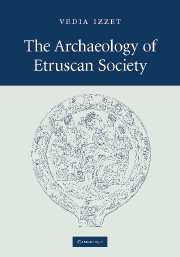Book contents
- Frontmatter
- Contents
- List of illustrations
- Acknowledgements
- List of abbreviations
- Introduction
- 1 Models of change in Etruria
- 2 Etruscan mirrors: reflections on personal and gender identity
- 3 Funerary architecture: the living and the dead
- 4 Sanctuaries: the sacred and the profane
- 5 Domestic architecture: public and private
- 6 Urban form and the concept of the city
- 7 Making Etruscan society: culture contact and (material) culture change
- Bibliography
- Index
5 - Domestic architecture: public and private
Published online by Cambridge University Press: 10 May 2010
- Frontmatter
- Contents
- List of illustrations
- Acknowledgements
- List of abbreviations
- Introduction
- 1 Models of change in Etruria
- 2 Etruscan mirrors: reflections on personal and gender identity
- 3 Funerary architecture: the living and the dead
- 4 Sanctuaries: the sacred and the profane
- 5 Domestic architecture: public and private
- 6 Urban form and the concept of the city
- 7 Making Etruscan society: culture contact and (material) culture change
- Bibliography
- Index
Summary
Introduction
According to Torelli, the late sixth century was ‘un momento cruciale’ in the urban development of Etruria (Torelli 1985: 32). This chapter traces the archaeological remains of Etruscan domestic architecture from the Iron Age in order to examine what led to this crucial moment and what form it took. The period from the eighth to the fourth century in Etruria was one that saw great changes in domestic architecture: not only the replacement of curvilinear structures by rectilinear ones, but also an increase in the regularity of these structures, both internally and externally, to such an extent that, by the fifth century, large, regular blocks of houses were constructed. In attempting to understand these wider changes, this chapter will examine the underlying network of smaller changes in the material culture: for example architectural form, the materials used in construction, the internal structure, and the treatment of entrances.
The changes in house form will be considered as a further element of Etruscan culture that will illustrate the importance of boundaries and differentiation in late sixth-century Etruria. As discussed in Chapter 1, the premium placed on the definition of boundaries was materially manifest in the creation and manipulation of surface. In the case of domestic architecture, the most obvious difference articulated is that between the private and the public spheres. Cultural changes in attitudes towards this difference are mirrored in changes in the physical relationship between inside and outside the house.
- Type
- Chapter
- Information
- The Archaeology of Etruscan Society , pp. 143 - 164Publisher: Cambridge University PressPrint publication year: 2007



